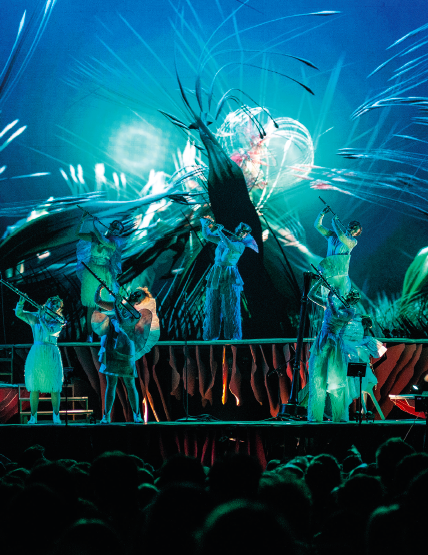Björk’s vision for her most elaborate and experimental stage concert yet required the right technology to turn her ideas into reality. FOH engineer, John Gale explains how d&b’s Soundscape system is changing the sonic landscape across the live events industry.
Following a world premiere at New York City’s The Shed and a residency at Mexico City’s Parque Bicentenario, Björk announced her European premiere of her Cornucopia show at London’s The O2 in late 2019.
Describing it as her most elaborate stage concert yet, and breaking new ground in terms of technology meets art, Cornucopia is a digital theatre performance crafted around Björk’s most recent album, Utopia.
Innovative to its core, Cornucopia embraces the very latest in immersive audio technology thanks to its use of d&b Soundscape, a 360 sound system that immerses fans in a sensory techno-acoustic utopia.
Powered by the DS100 Signal Engine, an audio system processor based on a powerful Dante enabled signal matrix, d&b Soundscape facilitates unparalleled creativity through its two software modules En-Scene and En-Space.
Tasked with helping realise Björk’s sonic vision was FOH engineer, John Gale, who says the singer was keen to see how he could transfer her ideas into a live scenario.
“She’s very clear in what she wants to do and has strong ideas, and we don’t always know what curveball might be thrown in the next day,” begins Gale. “It’s good fun; I look forward to the challenge each time it comes up. When I started on the Utopia project, Björk came to us just before the first show and said, ‘Is there any chance we can have some bird effects coming from behind?’ That was the first clue that I knew we were going to head down that route!”
Björk was keen to try d&b’s Soundscape system to see if it was right for her needs, and had a small demo system sent to her space inside a lighthouse in Iceland.
“She came up with a load of ideas before I even got in the room with her, and what’s great about this system is it can scale from a small space up to a massive space like an arena,” Gale points out.
“So once you’ve made your decision, the software will work out the maths and allow you to place more speakers into a setup. Each time we went to pick a venue, it would all scale up. We were really pleased with the result, because we didn’t actually know how well it would work with these really large venues!”
The team were one of the first to try the system in an arena-sized venue: “We were really, really happy and super excited once we were listening to it and realising that we were going to pull this off!”


